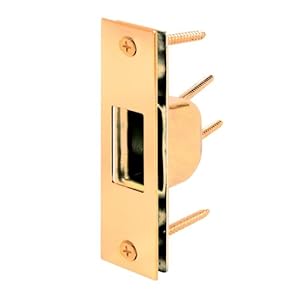JohnDennis
Member
I looked for a good way to reinforce the deadbolt latch plates on my house. All of the commercially available products were either ugly or poorly designed.
A standard door latch plate is secured to the door frame itself which is usually made of thin soft wood. The door is installed in a rough opening in the frame of the house. Because of this, the distance between the wall studs and the frame is very random. To make things even more difficult, the two screws that secure the strike plate are at the inside edge of the stud, so longer screws will not help much.

The white you see on the left is the sheet rock. The vertical line between the two screws is the stud beginning to split because of the larger screws I installed.
I am unable to post multiple photos of any size in one post, I apologize in advance for posting this as a series of replies. I do not have any expertise in home automation or alarms. I am a skilled handyman and work with wood, metal, electricity, and machine tools. Just wanted to contribute something about home security.
A standard door latch plate is secured to the door frame itself which is usually made of thin soft wood. The door is installed in a rough opening in the frame of the house. Because of this, the distance between the wall studs and the frame is very random. To make things even more difficult, the two screws that secure the strike plate are at the inside edge of the stud, so longer screws will not help much.

The white you see on the left is the sheet rock. The vertical line between the two screws is the stud beginning to split because of the larger screws I installed.
I am unable to post multiple photos of any size in one post, I apologize in advance for posting this as a series of replies. I do not have any expertise in home automation or alarms. I am a skilled handyman and work with wood, metal, electricity, and machine tools. Just wanted to contribute something about home security.









